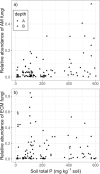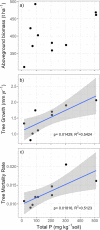Soil properties explain tree growth and mortality, but not biomass, across phosphorus-depleted tropical forests
- PMID: 32041976
- PMCID: PMC7010742
- DOI: 10.1038/s41598-020-58913-8
Soil properties explain tree growth and mortality, but not biomass, across phosphorus-depleted tropical forests
Abstract
We observed strong positive relationships between soil properties and forest dynamics of growth and mortality across twelve primary lowland tropical forests in a phosphorus-poor region of the Guiana Shield. Average tree growth (diameter at breast height) increased from 0.81 to 2.1 mm yr-1 along a soil texture gradient from 0 to 67% clay, and increasing metal-oxide content. Soil organic carbon stocks in the top 30 cm ranged from 30 to 118 tons C ha-1, phosphorus content ranged from 7 to 600 mg kg-1 soil, and the relative abundance of arbuscular mycorrhizal fungi ranged from 0 to 50%, all positively correlating with soil clay, and iron and aluminum oxide and hydroxide content. In contrast, already low extractable phosphorus (Bray P) content decreased from 4.4 to <0.02 mg kg-1 in soil with increasing clay content. A greater prevalence of arbuscular mycorrhizal fungi in more clayey forests that had higher tree growth and mortality, but not biomass, indicates that despite the greater investment in nutrient uptake required, soils with higher clay content may actually serve to sustain high tree growth in tropical forests by avoiding phosphorus losses from the ecosystem. Our study demonstrates how variation in soil properties that retain carbon and nutrients can help to explain variation in tropical forest growth and mortality, but not biomass, by requiring niche specialization and contributing to biogeochemical diversification across this region.
Conflict of interest statement
The authors declare no competing interests.
Figures








